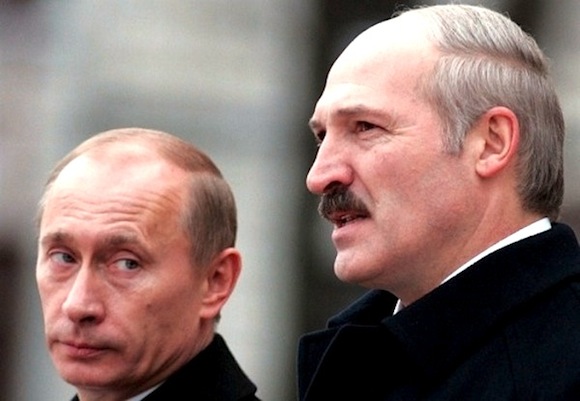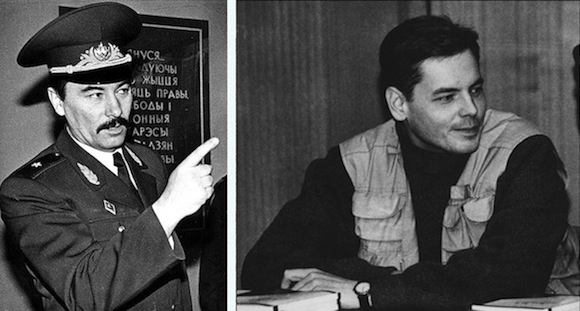The Institute of Modern Russia continues its series of article on the political history of contemporary Belarus. In the first installment, we focused on the reasons for the failure of Belarusian ethnic national project; the mistakes of the post-Soviet democratic period; Alexander Lukashenko's fast rise to power; and transformation of the country into a presidential republic. In the second article of the series, we will speak about political repressions under Lukashenko's rule and his political maneuvring of the last 15 years between Europe and Russia. It appears that Belarusian president has recently become fully dependent on the Kremlin's and Vladimir Putin's will.

As Andrei Yegorov, director of the Center for European Integration, points out, relationship between Russian President Vladimir Putin (left) and Belarusian President Alexander Lukashenko (right), can be described as "Oil-for-Kisses Programme."
Political Repressions
In 1996, a new political reality came to Belarus. Lukashenko dissolved the Supreme Soviet and in its place appointed, by a presidential decree, 110 former Deputies that were most loyal to him to a newly created National Assembly. In response, the European Union, the Council of Europe, and OSCE recognized as lawful a group of 40 former Belarusian parliamentary members, led by Semyon Sharetsky, who who remained faithful to the 1994 Constitution of Belarus and claimed that the 1996 referendum was a state coup. Until 2001, this group participated in the sessions of the Parliamentary Assembly of the Council of Europe (PACE) with the status of “government in exile.” But despite support from the West, this group never became a potent political force. Moreover, for a long period of time political activities of this group created the illusion within the Belarusian opposition that their struggle against Lukashenko’s regime might get help from abroad.
The collapse of the Belarusian party system resulted in usurpation of all branches of authority by one man—Alexander Lukashenko. His next step in his quest for increased power was the purging of the political arena through eliminating all potential rivals.
In July 1999, Viktor Gonchar, former head of Belarusian Central Election Commission (CEC) was elected as acting chairman of the 13th Supreme Soviet that had been unlawfully dissolved by Lukashenko in 1996. Gonchar headed the Soviet’s special commission for legal investigation of Lukashenko’s contravention of the Belarusian Constitution and other laws.
The collapse of the Belarusian party system resulted in usurpation of all branches of authority by one man—Alexander Lukashenko.
In September, the Commission issued its report which found that the constitutional amendments imposed by Lukashenko in November 1996, were a “seizure of power by non-constitutional methods.” This report was scheduled to be signed on September 19th, 1999 at a meeting of the 13th Supreme Soviet members and be the basis upon which further legal actions could be taken. However, on September 16th, Viktor Gonchar and his friend Anatoly Krasovsky, a Belarusian businessman, went missing in Minsk and the Supreme Soviet meeting was cancelled. Thus, a unique moment to create a legal precedent and to initiate a procedure to remove Lukashenko from power was lost.
According to Belorusskaya Narodnaya Gazeta and Narodnaya Volya, Lukashenko assigned Yuri Sivakov, Minister of Internal Affairs, to handle the situation. The latter supervised a secret rapid-response team headed by Dmitri Pavlyuchenko that was created to eliminate the President’s opponents (called “the death squadron”). There is a strong likelihood that Viktor Gonchar and Anatoly Krasovsky were killed by orders of the Belarusian president.

In 1999, a number of Lukashenko's political opponents went missing in Belarus. Among them were former Minister of Internal Affairs Yuri Zakharenko (left) and cameraman of the Russian TV Channel ORT (First Channel) Dmitri Zavadsky (right).
On May 7, 1999, a former Minister of Internal Affairs Yuri Zakharenko went missing as well. Vladimir Borodach, a reserve military officer and a former GRU (Foreign Military Intelligence) Colonel, who knew Zakharenko personally and investigated the case, later reported that Zakharenko had been kidnapped by the “death squadron.” He was beaten and tortured in order to get him to confess that he was planning a coup. Since Zakharenko never confessed, he was killed.
That same year another man went missing—Dmitry Zavadsky, cameraman for the Russian TV Channel ORT (now First Channel) disappeared right before he was supposed meet with the journalist, Pavel Sheremet. (Both had been arrested in Belarus in 1997 for their coverage of problems on the Belarus-Lithuania border.) Zavadsky drove to Minsk airport where he was supposed to meet Sheremet but disappeared and the meeting never took place. Shortly before his disappearance, Zavadsky had gone on a business trip to Chechnya and, according to one version, he was murdered because he had discovered compromising information about Lukashenko during that trip.
In his book Firing Party, Oleg Alkayev, a former director of Pre-Trial Detention Center No. 1 in Minsk writes: “Many people, hypnotized by the President’s eloquence, or rather phrase-mongering, sincerely believe that all the horrible crimes—the kidnapping and killing of people—were committed by a gang of scoundrels who took advantage of a trusting President who cannot keep an eye on everything. <...> For a long time, I was under this hypnotic spell. President’s demagogy <…> was having its bad effect. With his good acting skills, determination, and utter cynicism, Lukashenko was able to repress, in quite a short period of time, the strong resistance of independent politicians. He forced some of them to emigrate, lured others to his side, and destroyed the toughest, most implacable and dangerous opponents, like Yuri Zakharenko and Viktor Gonchar.”
After Viktor Gonchar went missing in Minsk, a unique moment to create a legal precedent and to initiate a procedure to remove Lukashenko from power was lost.
As Anatoly Lebedko, leader of the United Civil Party, described the political situation in Belarus to IMR, Lukashenko’s regime is based on three pillars: “First, it’s fear, which is used by the regime to maintain total control and influence the public. Belarusian siloviki have carte-blanche to take repressive measures against the dissidents. At the legislative level, the Belarusian KGB is allowed, without the need of anyone’s permission, to enter any premises at any time and to use violence and weapons. Secondly, the majority of the population is economically dependent on the regime. Eighty percent of the population receive their salaries, pensions, allowances, stipends, etc. from Lukashenko. People don’t have any alternatives. Thirdly, the Kremlin, who provides Lukashenko with financial support and defends Belarus’ interests before international organizations. Without Russian aid, Lukashenko would have been unable to fulfill the social contract with the majority of the population, at least until the recent economic crisis.”
Russian Vector
The current geographical position of Belarus—at the crossroads of two power centers (Russia and Europe)—predetermined that it would be an object in the competition between those powers for the regional domination. As analysts have observed, the limitrophe paradigm, that is, the paradigm for relations of a country located between two powers applies to Belarus and its relations with the European Union and Russia: when relations with one deteriorates, the relations with the other improves.

From the very beginning of his political career Alexander Lukashenko has publicly declared that Russia will be a priority of his foreign policy. On the photo (left to right): Russian Prime Minister Dmitri Medvedev, Belarusian president Alexander Lukashenko, Russian President Valdimir Putin.
From the very beginning of Lukashenko’s political career, he has stated that Russia would be a priority in his foreign policy. After the 1996 referendum, the results of which had not been recognized by the European countries, Lukashenko distanced himself from the EU. In its turn, the EU excluded Belarus from its European Neighborhood Policy—a foreign policy instrument that was developed to create a “circle of friends” with countries located along the EU's borders. At that moment, the future dictator was hardly interested in European partnerships. Far more attractive to him was creating a Union State of Russia and Belarus.
Lukashenko’s ambitions were quite obvious and even more far-reaching. The Belarusian president’s objective was for a Union State in which: (a) the decisions made by supreme authorities would be mandatory for both countries; and (b) he would be its leader. Russia was not satisfied with such an arrangement. Russian President Boris Yeltsin insisted that Belarus accelerate privatization and democratize internal politics. Negotiations on the issue reached a dead-end, and the document that was eventually signed contained no concrete obligations for either side. The relations between Minsk and Moscow grew even colder after the arrest of Dmitry Zavadsky and Pavel Sheremet. Moscow used its economic and political leverage to deal with the situation and the process of integration came to a halt.
In 2000, an agreement on creating the Union was finally signed. However, when Vladimir Putin came to power, the rules of the game changed in this forced Lukashenko to rebuild his relations with Moscow. The transit of gas from Russia to Europe through Belarus became the cornerstone of his politics.

